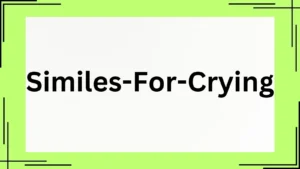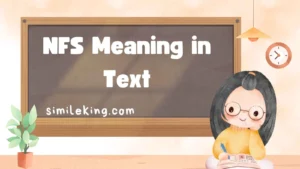Similes and metaphors are powerful tools in the English language that make descriptions more vivid and engaging.
For kids, learning these figurative language devices can help them express themselves in creative and fun ways.
In this article, we will explore various examples of similes and metaphors that are perfect for children.
Whether for writing exercises or day-to-day conversations, these examples will make language come alive and bring excitement to the way kids use words.
What Are Similes and Metaphors?
Before we dive into examples, let’s first understand what similes and metaphors are.
- Similes: A simile is a comparison between two different things using the words “like” or “as.” They help to make descriptions more relatable and understandable. For instance, saying “as busy as a bee” helps the listener imagine just how active someone is by comparing them to a bee, which is known for its constant movement.
- Metaphors: A metaphor, on the other hand, directly equates one thing to another. It says something is something else, without using “like” or “as.” For example, “The world is a stage” is a metaphor that suggests life can be like a performance.
Now that we know the difference, let’s explore various examples of each, especially geared towards young learners.
10 Simile Examples for Kids
Similes are an excellent way to spark a child’s imagination. Below are 10 simple and fun similes that kids can use to describe various situations.
1. As fast as a cheetah
This simile is great for describing something or someone moving very quickly.
Example: “She ran as fast as a cheetah during the race.”
2. As bright as the sun
This is perfect for describing something that shines or is exceptionally bright.
Example: “The stars were as bright as the sun in the clear night sky.”
3. As quiet as a mouse
This is a common way to describe someone who is being very quiet.
Example: “He was as quiet as a mouse when he sneaked into the room.”
4. As cold as ice
Use this simile when talking about something that is freezing or very cold.
Example: “The water in the fridge is as cold as ice.”
5. As strong as an ox
This simile is ideal for describing someone with a lot of physical strength.
Example: “My brother is as strong as an ox when he helps with the chores.”
6. As sweet as honey
This is a lovely way to describe something that tastes sweet or a person who is very kind.
Example: “Her voice is as sweet as honey.”
7. As gentle as a lamb
Use this simile to describe someone or something that is very gentle or peaceful.
Example: “The puppy was as gentle as a lamb, letting the children pet it.”
8. As heavy as a ton of bricks
This is useful when describing something that is extremely heavy.
Example: “That backpack is as heavy as a ton of bricks!”
9. As slow as molasses
A fun simile to describe something moving slowly, this is a playful way to describe sluggishness.
Example: “The snail is as slow as molasses in the cold weather.”
10. As tall as a giraffe
Great for describing something or someone very tall.
Example: “He’s as tall as a giraffe, reaching the top shelf easily.”
10 Metaphor Examples for Kids
Metaphors are more direct and can create powerful imagery. Here are 10 kid-friendly metaphors that will help kids express themselves in exciting ways.
1. Time is a thief
This metaphor suggests that time passes quickly, and once it’s gone, it’s lost forever.
Example: “I can’t believe how quickly the summer ended. Time is a thief.”
2. The classroom was a zoo
This metaphor compares the chaotic classroom to a zoo, implying there was a lot of noise and disorder.
Example: “When the bell rang, the classroom was a zoo, with kids shouting and running around.”
3. Her heart is a rock
This is a metaphor for someone who is emotionally tough or unfeeling.
Example: “After all that happened, she acted like her heart was a rock, not showing any emotion.”
4. He’s a shining star
A metaphor like this suggests someone who stands out and is exceptional in some way.
Example: “She’s a shining star on the soccer team, always scoring goals.”
5. The world is a stage
This is a classic metaphor by William Shakespeare that compares life to a performance, where everyone has a role.
Example: “The world is a stage, and each person has their time to shine.”
6. She’s a walking dictionary
This metaphor describes someone who knows a lot of words or facts, much like a dictionary.
Example: “When it comes to trivia, she’s a walking dictionary.”
7. His mind is a steel trap
This metaphor refers to someone who has an excellent memory or sharp thinking skills.
Example: “Don’t worry, his mind is a steel trap—he’ll remember that information.”
8. The book was a rollercoaster of emotions
This metaphor compares the emotional ups and downs of a book to a thrilling rollercoaster ride.
Example: “The story was a rollercoaster of emotions, making me laugh and cry.”
9. Her smile is sunshine
This metaphor suggests that a person’s smile brings warmth and happiness, much like the sun.
Example: “Whenever she smiles, her smile is sunshine to everyone around her.”
10. The homework mountain
This metaphor can be used when there’s a lot of homework to do, comparing it to an overwhelming mountain.
Example: “I have to climb the homework mountain tonight, but I’m determined to finish it.”
Why Are Similes and Metaphors Important for Kids?
Similes and metaphors are not just fun figures of speech; they also play a key role in developing language and cognitive skills. By using them, kids can:
- Enhance Creativity: Both similes and metaphors encourage kids to think outside the box and create unique descriptions.
- Improve Writing Skills: Adding figurative language helps kids express themselves more vividly, making their writing more engaging.
- Boost Comprehension: When kids learn to recognize similes and metaphors, they also improve their ability to understand and interpret literature.
- Better Communication: These language tools help kids communicate their feelings, thoughts, and ideas in a clearer, more colorful way.
Conclusion
Similes and metaphors are essential elements in the English language, and they can be especially fun and educational for kids to learn. By using these examples, children can enhance their creativity, improve their communication skills, and make their writing come to life. Encouraging kids to use these figurative language devices will help them become more expressive and confident in their language use, setting them up for success in both their academic and personal lives.





